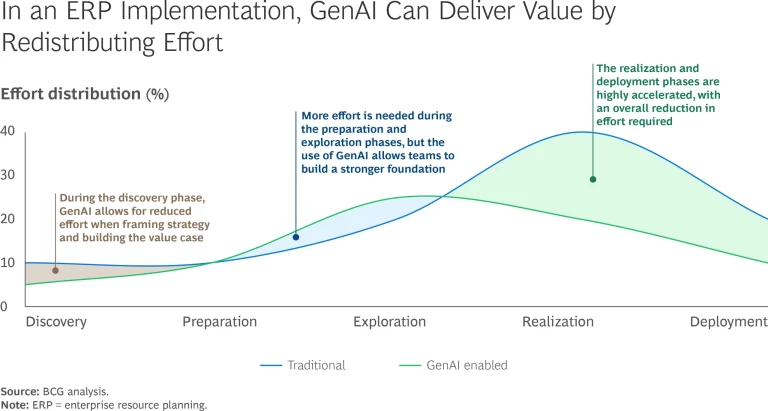Enterprise resource planning (ERP) programs deliver long-term organizational benefits, including increased automation, simplification of processes, future-proofing, and the flexibility to accommodate evolving business needs and operating models. However, they are notorious for their complexity, frequently running over budget and schedule. Data from Panorama, a consultancy, shows that roughly a third of projects run over budget, and nearly 20% take longer than expected.
As organizations increasingly seek faster, smarter, and more agile ERP solutions, generative AI (GenAI) is proving to be a game-changer, enhancing everything from requirements gathering to post-implementation support. We estimate that GenAI can already reduce the effort for an organization-wide ERP implementation by 20% to 40%. (These benefits complement, but are separate from, the benefits that GenAI brings once an ERP is in operation.)
In the very near future, perhaps within three years, the acceleration from GenAI will dramatically increase, allowing firms to build more advanced ERP solutions five times faster than with traditional methods. GenAI-enabled ERP implementation will not only accelerate the time to value realization for businesses but deliver value in new and innovative ways, without the constraints or boundaries of a traditional program.
GenAI eases the pain of ERP implementation by addressing the challenges that have traditionally plagued the process. By automating key tasks, enhancing decision making, and redistributing effort across the transformation lifecycle, GenAI allows companies to streamline tasks that were once manual and error prone.
GenAI eases the pain of ERP implementation by addressing the challenges that have traditionally plagued the process.
A critical part of this is resource shifting. Using GenAI means implementation teams can reduce the effort expended in the resource-intensive, later-stage processes of ERP delivery (realization and deployment). Instead, they can deploy these resources in the earlier discovery, preparation, and exploration phases, which contribute most to delivering business outcomes. (See the exhibit.) This, in turn, reduces uncertainty and risk.

That assistance is very timely. Vendor SAP says it will reduce support for ECC, its traditional ERP offering, in 2027. But just 37% of its approximately 35,000 customers had licensed its more advanced, cloud-ready platform by mid-2024, according to Gartner. The slow pace of migration may be one reason why earlier in 2025 SAP announced it would offer limited, extended support for some customers. Nevertheless, many firms are standing at the threshold of moving their ERP to the cloud—a journey that GenAI can turbocharge.
As a mighty bonus, a GenAI-powered ERP implementation can also be a force for change inside the organization. By driving a rethink on how large-scale tech projects are designed and executed, other large-scale projects can follow, resulting in similar benefits, reduced costs, and better value creation.
This is a fast-developing field, and the power of GenAI in ERP implementations is only just becoming clear. As such, estimating the savings is an inexact science. Nevertheless, the actions we suggest in this article can serve as a guide.
Subscribe to our Digital, Technology, and Data E-Alert.
Enhancing Strategy and Framing
The critical early stages of an ERP rollout are often blighted by an incomplete understanding of the current state and stakeholder misalignment. If not addressed, these issues significantly increase delivery risk later in the project. GenAI offers transformative opportunities to overcome these challenges, especially when it comes to enriching the as-is state analysis and automating requirements gathering. By using GenAI in these areas, organizations can achieve a de-risked delivery during the strategy and framing phase, with greater clarity on current and future operational landscapes. The technology can help do the following:
- Automate the Gathering of Requirements. GenAI can reduce the time spent on this process, which is usually manual and prone to error, by 30% to 60%. Using a large language model (LLM) is ideal for capturing, categorizing, and prioritizing business needs from inputs such as stakeholder interviews, system data, and business objectives. In practice, this means deploying your chosen LLM onto a requirements management tool. The cost savings are helpful, but the real benefits are strategic: business needs can now be documented and prioritized according to strategic objectives, aligning stakeholders and in turn generating multiple follow-on benefits later in the process.
- Improve the Analysis of Transformational Potential. GenAI, combined with process mining tools, can yield very important insights. The result will be better analysis and a 20% to 40% reduction in time spent on this task. At a practical level, this means AI-driven simulation tools can be integrated with current ERP systems to simulate various to-be target scenarios, providing insights into potential future states and offering a predictive analysis of their performance. This ensures that ERP transformation targets are data driven, aligning short- and long-term business goals. It will also generate quicker harmonization of technical capabilities and strategic objectives.
Streamlining Execution and Implementation
The streamlining and execution phases are often the most challenging for ERP projects, plagued by scope creep, timeline delays, and compromised quality. GenAI’s ability to automate tasks and enhance decision making during these stages offers significant advantages, including helping teams reduce manual efforts and allowing them to focus on higher-value activities. Here, there are five main categories of benefits:
Enriched Understanding of the As-Is State. GenAI can analyze organizational data, such as legacy system code, process flows, and functional specifications, offering a more comprehensive view of the as-is state. That can lead to a time reduction of 20% to 50% for this phase. At a technical level, this means deploying an LLM tool onto document repositories. It could also mean leveraging tools that utilize GenAI, such as LeanIX inventory builder or SAP Signavio repository builder, to assess as-is business processes and technology architecture. The resulting richer understanding allows for more precise decision making, reducing blind spots that are common in traditional approaches.
When BCG undertook its own ERP transformation, a key challenge was the lack of knowledge about the legacy code base, which had been developed decades ago. GenAI rapidly generated an understanding of the old information, translating highly technical code into business process language. This accelerated design workshops for the new system, making the transition smoother and more efficient.
Faster Production of Documentation. LLMs can reduce time spent on document creation and updates by 30% to 50%. They can be integrated with document management solutions to automate the creation and updating of documentation, including functional specifications, technical designs, and test cases. These tools can also be connected to project management platforms for real-time updates and improved consistency, freeing up teams to focus on higher-value tasks.
Automated Data Cleansing and Mapping. GenAI-powered data intelligence tools can automate much of the data cleansing and mapping process—typically one of the most complex aspects of an ERP transformation—by automating a large part of the “extract, transform, and load” data migration. This can reduce data preparation and mapping time by 20% to 30% and ensure that cleansing and mapping is completed to a high standard. It can also reduce the time for each data migration cycle (testing based on simulated data before the final cutover), thus allowing for more testing cycles. This smooths the path from legacy systems to the new ERP environment.
As an example, one large European energy company faced inefficiencies in data mapping activities, which traditionally consume significant time during ERP transformations. The company integrated GenAI into its data-mapping processes, enabling a more automated and intelligent approach, reducing the time required for data mapping, and improving the speed and quality of mock data migration cycles. This example underlines how GenAI can accelerate ERP data migrations, reaching near-production data quality faster and with higher accuracy and reducing overall transformation costs.
Streamlined Development of Customization Code. GenAI can reduce the time required to create and validate the complex, company-specific code that connects multiple modules and systems by 30% to 40%. What’s more, code generation models can automate quality checks and improve consistency. This drives standardization and best practice, reducing the risk of errors. ERP vendors are leading the way by offering GenAI-powered tools (such as SAP’s Joule) that help develop quality code in record time.
Better, More Comprehensive Testing. The time GenAI can help save during testing can be a dramatic 60% to 70%, but this is just one of the benefits. The technology is exceptional at generating test scripts driven by design documentation, historical testing results, performance data, and defect reports. These scripts can cover functional and non-functional requirements and get closer than traditional methods to achieving 100% test coverage. This wider spread of scripts can then be executed by automated testing tools to ensure defects are detected early, and they add extra rigor to the testing process.
Faster Upskilling for Both the IT Team and the Wider Organization. The human side of an ERP implementation is critical. AI-powered chatbots, after ingesting project documentation, can be integrated with learning platforms. Lengthy training for the implementation teams can be replaced with in-context, just-in-time knowledge transfer. Compared with traditional learning methods, the time it takes to onboard new team members can be cut by 50% to 60%. Plus, once the ERP is live, user errors due to inadequate training can be reduced by 50%. GenAI does this through snack-sized coaching sessions and chatbots that can offer personalized tips based on user behavior and problems.
Faster Realization of Value
The big battle, however, is yet to come. After implementation, the focus shifts to value realization, where GenAI can help ensure ongoing performance optimization. This phase presents challenges such as performance degradation, unresolved technical issues, and insufficient system monitoring, and GenAI can assist with each of those issues by offering predictive insights and real-time support.
GenAI accelerates ROI by flattening the traditional “hockey stick” curve of delayed value realization.
Through these applications, GenAI accelerates ROI by flattening the traditional “hockey stick” curve of delayed value realization. It helps organizations achieve the long-term benefits of their ERP implementations while maintaining system performance and optimizing operations. Thanks to earlier process improvement, GenAI can deliver in three main areas:
Faster Deployment Using Virtual Assistants. Users on IT teams and in the wider organization will need help with many queries, and this will slow deployment. GenAI-powered virtual assistants can resolve routine questions and provide rapid assistance to users. Support tasks that need manual assistance can be cut by 60%, freeing human resources to tackle more strategic implementation issues.
For example, after deploying its ERP system, BCG needed to assist the IT team and broader organization with quick and accurate responses to technical and functional queries. To deliver this, a custom GPT was trained on company-specific training guides, code, and other business and technical solution documentation. This faster troubleshooting of user errors and deep dives into incident resolution improved system usability and operational efficiency. This approach demonstrates how AI-driven assistance in ERP ecosystems can improve user experience, reduce downtime, and optimize IT support processes.
Enhanced Reliability with Predictive Maintenance. Unplanned downtime early in a project’s life gives it a bad reputation among users, but implementing predictive maintenance powered by GenAI can reduce that downtime by 50% to 60%. The GenAI models can be integrated with predictive analytics tools to continuously monitor system logs and hardware sensors, helping identify potential risks before they escalate. This proactive approach keeps system performance steady and reduces the need for reactive maintenance.
Continuous Value Tracking. The important but much overlooked task of tracking value can help ensure that the substantial investment in an ERP delivers maximum return. Here, GenAI can act as a strong link between IT and the business, producing insights holistically across both business departments and architecture functions, driving additional value through an ongoing combination of process mining and architecture management.
Unlocking Efficiency Across the ERP Capability Map
The integration of GenAI into ERP transformation programs drives efficiency across both strategic and operational roles, in different ways.
Strategic roles, such as executive sponsors and program directors, benefit from enhanced decision making enabled by real-time insights and predictive analytics. For example, program directors can track project health and risks using GenAI-powered dashboards, allowing for more agile resource allocation and alignment with business objectives. While these roles are less affected by automation, they gain valuable efficiencies by reducing manual oversight and focusing on high-impact decision making.
Operational roles see transformative gains through automation and optimization. Functional consultants can leverage GenAI to streamline fit-gap analysis and process mapping, drastically accelerating delivery timelines. Similarly, testers benefit from automated test case generation and execution. GenAI can help teams identify defects earlier and ensure greater accuracy with less manual effort. Data migration specialists and developers can also experience substantial improvements, with GenAI automating data cleansing, mapping, and repetitive coding tasks, freeing them to focus on higher-value challenges.
These operational improvements have a positive impact on strategy too; better and faster execution provides more reliable and more timely data for governance and decision making.
Starting the Journey
Integrating GenAI into ERP transformations requires careful planning. By focusing on the following critical success factors, organizations can navigate the complexities of ERP projects and maximize the benefits of GenAI:
Readiness of Platforms, Processes, and People. The first step is ensuring that ERP systems, business processes, and project team members are prepared to support GenAI capabilities. This involves assessing and upgrading existing technology infrastructure to accommodate AI tools and integrations. Adapting core business processes (such as procurement, order management, and financial reporting) is essential to integrating AI-driven automation. Targeted training can equip team members—including project managers, business analysts, functional consultants, and technical developers—with the skills necessary to effectively leverage GenAI technologies.
Adoption of GenAI-First Implementation Methodologies. Organizations must move beyond traditional project management approaches to create a GenAI-first mindset that integrates AI capabilities throughout the ERP transformation lifecycle. The real benefits of GenAI do not come from a “low-hanging fruit” mindset; they can only be realized if the technology is deployed consistently, aided by continuous feedback loops driven by AI insights to improve decision making across all phases.
The real benefits of GenAI do not come from a “low-hanging fruit” mindset; they can only be realized if the technology is deployed consistently.
Robust Data Governance and Ethical AI Practices. It’s vital to establish strong governance and ethics practices. Some examples include:
- Establishing Strong Data Governance Frameworks and Ethical AI Practices. These are essential for maintaining compliance and security within ERP transformations.
- Developing Protocols for Data Privacy. Doing so ensures adherence to regulations and standards.
- Implementing Guidelines to Prevent Biases in AI Algorithms. Such guidelines are essential in processes like demand forecasting or financial analysis in protecting the integrity of decision making.
- Enhancing Cybersecurity Measures. Always important for a system that will become, in effect, the organization’s central nervous system, these security measures help safeguard the sensitive operational and financial data that AI models process.
Strategic Collaboration and Proactive Change Management. Effective collaboration across cross-functional teams is vital for the success of GenAI-enabled ERP transformations. Involving key stakeholders such as business process owners, subject matter experts, IT professionals, AI specialists, and end users in decision making ensures alignment with organizational goals. Conducting workshops such as fit-to-standard sessions, business process modeling, and solution design meetings can facilitate shared understanding and consensus. Proactive change management activities, including communication planning and stakeholder engagement, promote smoother transitions and greater buy-in throughout the transformation process.
Focused Upskilling and Training Initiatives. Investing in upskilling and training empowers both IT teams and the wider organization to maximize the benefits of GenAI throughout the ERP project. As mentioned earlier, AI can turbocharge many aspects of this upskilling process, making it more focused and efficient. It is vital that the training be role specific to make sure that team members get the most from the AI tools. More broadly, fostering a culture of continuous learning encourages adaptation to new technologies, ensuring that the organization remains agile during and after deployment. That learning should include knowledge transfer mechanisms that promote the sharing of best practices between implementation partners and internal teams.
By concentrating on these critical success factors, organizations can proactively address potential challenges and lay a sturdy foundation for a successful GenAI-enabled ERP transformation. These focused efforts will help ensure that the integration of GenAI is both technically sound and strategically aligned with organizational objectives. That will set the stage for immediate and sustained success in optimizing enterprise operations.
The Next Frontier for AI in ERP
The era of traditional costly and slow ERP implementations will soon be behind us. High-quality solutions are being offered at unprecedented speed as GenAI capabilities in this area increase rapidly. Part of this will be at a technical level: LLMs are getting ever better at applying logical reasoning across big data sets. This type of improvement is a priority for the companies that develop these models, so progress will be brisk.
The real acceleration, though, will come from LLMs trained not on general language data but on ERP-related data sets, which will produce better-quality output and allow deployment in highly ERP-specific use cases. Vendors are progressing in building custom LLMs to support industry best practices and ERP-proprietary coding languages, but maturity is still in the distance, and effective use cases are scattered.
In time, full end-to-end ERP implementations could be delivered in under a year, requiring significantly less investment and as a result, drastically reduced risk. With this possibility, we could also see a shift away from single-instance ERP solutions toward multiple bespoke instances supporting business operations with more tailored solutions as they become simpler and quicker to deploy.
However, innovators should not wait for these ERP-specific GenAI technologies to mature. There are extraordinary gains to be made by using the more generalized GenAI offerings that are already on the market. Yes, there can be a cost, both financial and in terms of organizational learning. But given the importance of an ERP implementation to any organization and the risks of late delivery or going over budget, can your company afford not to use GenAI?














